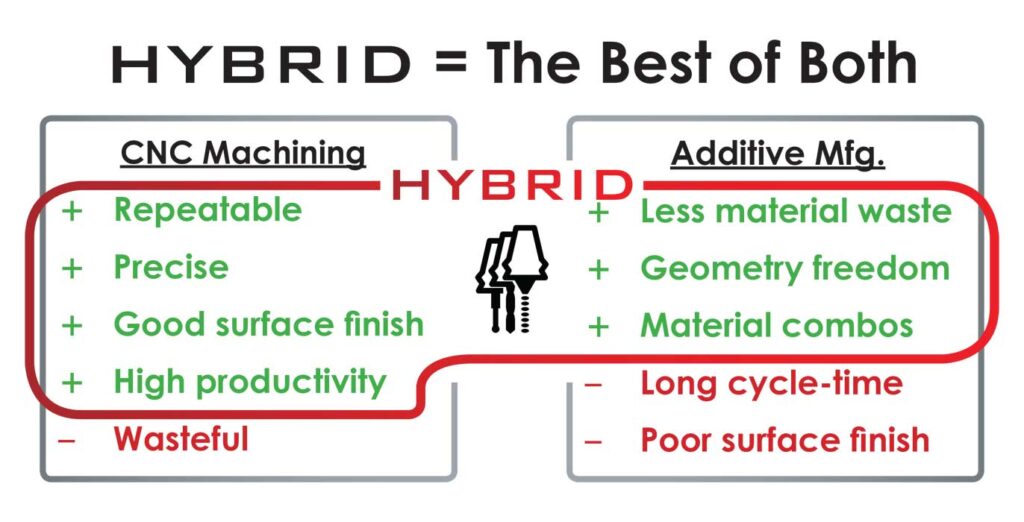Hybrid Manufacturing Technologies is dedicated to furthering the understanding of additive manufacturing and hybrid processing so we have created and curated the following resources:
7 Families of Additive Manufacturing
- A Quick Reference Guide -
Awareness of the working principles of additive manufacturing is foundational to understanding hybrid manufacturing.
To many, the term 3D printing conjures up only images of desktop polymer extrusion printers, but it embraces much more than that. In the last 30 years, the focus of 3D printing has grown from making prototypes using vats of resin and beds of powder, to include making production parts with metal and ceramics. These processes have collectively now become referred to as additive manufacturing (AM). Recent standardization activities by ASTM and ISO have grouped additive processes into seven categories.
Hybrid Manufacturing Technologies initially created this quick reference guide for internal employee training. It provides a basic illustration of each process and an overview description of how it works. Perhaps most conveniently, it helps map trade names and other terminology to technology families as standardized by ISO/ASTM. We are happy to share it externally and hope it will be useful for you.
Download a printer-friendly PDF version of the chart here. You can request a larger scale version through our contact page.

Hybrid Manufacturing Technologies
Prior to the mid-2010’s, the CNC world was largely an idle spectator to the advancements in additive manufacturing systems for metals. Compared to CNC machined components, most metal parts produced in layers (by AM) have inferior production rates and sub-standard surface finish, normally requiring post-machining. Furthermore, the cost of early metal AM systems was difficult to justify, even for high performance components. To end this historic “feud” between additive and subtractive technologies, hybrid machine tools, equipped for both CNC and AM, enabled the use of both technologies in optimal proportions as needed.
In 2012 Hybrid Manufacturing Technologies was founded to bring additive manufacturing to mainstream CNC machines. One year later, the first commercially available mainstream CNC machine equipped with additive capabilities was launched. In part due to this pioneering success, the generic term “hybrid manufacturing” has been applied to the emerging products and market that combines these two technologies.

Historically viewed as rivals, the conceptual leap to combine CNC with additive was rooted in the realization that although their natures were different, they were in fact complimentary. This was a crucial insight that motivated the invention of the AMBIT™ deposition system for hybridizing CNC machines.
Got an Incredible Project Right Now?
This helps ensure quality, schedule, and that we’re all working toward same goal.
Movies & Presentations
Hybrid CNC + Additive: Two Heads are Better than One
Conference Presentation at RAPID - 26 mins
This presentation at SME's RAPID exhibition (North America's largest event dedicated to additive and 3D printing) reviews the milestone events and institutions which helped transition the hybrid approach from the academic arena into full commercialization. The scope endeavors to be a holistic view across the industry including hybrid CNCs equipped with directed energy deposition, powder bed fusion, sheet lamination and material extrusion capabilities.
Scholarly Resources
J. B. Jones, ``Industrial 3D printing is coming to mainstream CNC`` published in CECIMO Magazine, Special Edition 2015 on Additive Manufacturing.
Gateways Toward Dissimilar Multi-material Parts
Remanufacturing of turbine blades... in a single machine
J. B. Jones, ``SME Technical Paper TP14PUB77: The Synergies of Hybridizing CNC and Additive Manufacturing,`` presented at the RAPID 2014 and 3D Imaging Conferences & Exposition, Detroit, MI, USA, 2014
Repurposing mainstream CNC machine tools for laser-based additive...
J. B. Jones, ``Repurposing mainstream CNC machine tools for laser-based additive manufacturing,`` in Proc. SPIE 9738, Laser 3D Manufacturing III, 973811, San Francisco, CA, USA, 2016, pp. 973811-973811-11.
